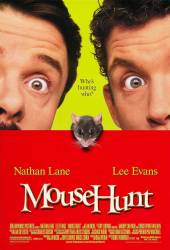Ernie: He's Hitler with a tail. He's "The Omen" with whiskers. Even Nostradamus didn't see him coming.
Lars: Look! You blew a hole in the floor.
Ernie: And I distinctly remember somebody yelling, "Shoot! Shoot!"
Lars: Yeah, well you never listened to me before.
Lars: We made love in a way I've-I've only ever seen in nature films.
Lars: Some things are more important than money, Ernie.
Ernie: Notice it's always the financially challenged who say that?
Ernie: Shh! He's goin' for the cherries.
Lars: I thought you said mice like Gouda.
Ernie: Not in the morning! Cheese tires them out. They need fruit for energy.
Ernie: I'm gonna build an Olympic-sized swimming pool and fill it with pina coladas and a college sorority.
Lars: You used to love string.
April Smuntz: That was before, when I was dating the son of wealthy string magnate! Not now when I am married to the half owner of a worthless deathtrap.
Ernie: Just think of all the trouble we could have saved ourselves if we just threw fruit at him in the first place.
Ingrid: Hilde, the spool is smoking.
Alexander: There's a lot of Eurotrash out there scarfin' up the shrimps.
Ernie: I don't think we're dealing with an ordinary mouse.






Answer: There's not really an answer, because the film has sort-of a nebulous timeframe given its cartoon-like atmosphere. Ex. Everything is old fashioned in design, including architecture and clothing, but current technology is also present. It's not really meant to take place in the "real world" or a specific timeframe, so much as be a silly throwback to old comedies and especially old Laurel and Hardy films. So, the best answer to your question would be that it just sort of exists in its "own" time, so to speak - an amalgam of different time periods all put together for maximum comedy impact.
TedStixon
Adding to this, the Wikipedia page on this movie states that... "The film is set in a humorously indeterminate 20th-century time period, with styles ranging from the 1940s to the 1990s."
Quantom X ★
"Mouse Hunt" was not modeled on 1930s Laurel and Hardy films so much as it was a direct retread of 1940s "Herman and Catnip" and "Tom and Jerry" cartoons, which spawned many knock-offs over the decades, from "Coyote and Roadrunner" cartoons to live-action comedies such as "Home Alone" and others.
Charles Austin Miller